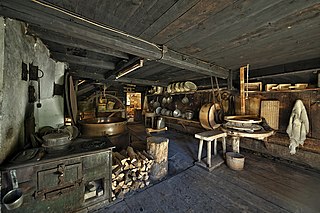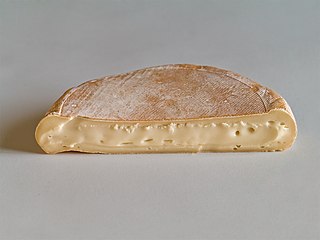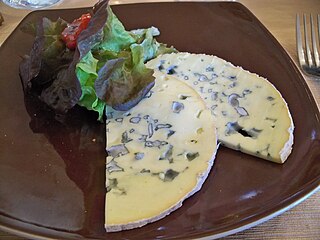
Dorset Blue Vinney is a traditional blue cheese made near Sturminster Newton in Dorset, England, from cows' milk. It is a hard, crumbly cheese. It was formerly made of skimmed milk.

A dairy is a place where milk is stored and where butter, cheese and other dairy products are made, or a place where those products are sold. It may be a room, a building or a larger establishment. In the United States, the word may also describe a dairy farm or the part of a mixed farm dedicated to milk for human consumption, whether from cows, buffaloes, goats, yaks, sheep, horses or camels.

Halloumi or haloumi is a cheese of Cypriot origin made from a mixture of goat's and sheep's milk, and sometimes also cow's milk. Its texture is described as squeaky. It has a high melting point and so can easily be fried or grilled, a property that makes it a popular meat substitute. Rennet is used to curdle the milk in halloumi production, although no acid-producing bacteria are used in its preparation.

Curd is obtained by coagulating milk in a sequential process called curdling. It can be a final dairy product or the first stage in cheesemaking. The coagulation can be caused by adding rennet, a culture, or any edible acidic substance such as lemon juice or vinegar, and then allowing it to coagulate. The increased acidity causes the milk proteins (casein) to tangle into solid masses, or curds. Milk that has been left to sour will also naturally produce curds, and sour milk cheeses are produced this way.

Goat cheese, goat's cheese or chèvre is cheese made from goat's milk. Goats were among the first animals to be domesticated for producing food. Goat cheese is made around the world with a variety of recipes, giving many different styles of cheeses, from fresh and soft to aged and hard.

Raw milk or unpasteurized milk is milk that has not been pasteurized, a process of heating liquid foods to kill pathogens for safe consumption and extending the shelf life.

Reblochon is a soft washed-rind and smear-ripened French cheese made in the Alpine region of Haute-Savoie from raw cow's milk. It has its own AOC designation.

Paneer, also known as panir, is a fresh acid-set cheese common in the cuisine of the Indian subcontinent made from full-fat buffalo milk or cow milk. It is a non-aged, non-melting soft cheese made by curdling milk with a fruit- or vegetable-derived acid, such as lemon juice.

Comté is a French cheese made from unpasteurized cow's milk in the Franche-Comté region of eastern France bordering Switzerland and sharing much of its cuisine. Comté has the highest production of all French Appellation d'origine contrôlée (AOC) cheeses, at around 66,500 tons annually. It is classified as an Alpine cheese.

Dunlop is a mild cheese or 'sweet-milk cheese' from Dunlop, East Ayrshire, Scotland. It resembles a soft Cheddar cheese in texture. Though it fell out of popularity some time after the end of the Second World War, it is now appreciated for its value in various recipes and for eating on its own or with a dram of whisky.

Saint-Nectaire is a French cheese made in the Auvergne region of central France.

Époisses, also known as Époisses de Bourgogne, is a legally demarcated cheese made in the village of Époisses and its environs, in the département of Côte-d'Or, about halfway between Dijon and Auxerre, in the former duchy of Burgundy, France, from agricultural processes and resources traditionally found in that region.

Camel milk is milk from female camels. It has supported nomad and pastoral cultures since the domestication of camels millennia ago. Herders may for periods survive solely on the milk when taking the camels on long distances to graze in desert and arid environments, especially in parts of the Middle East, North Africa and the Horn of Africa. The camel dairy farming industry has grown in Australia and the United States, as an environmentally friendly alternative to cow dairy farming using a species well-adapted to arid regions.

Fourme d'Ambert is a semi-hard French blue cheese. One of France's oldest cheeses, it dates from as far back as Roman times. It is made from raw cow's milk from the Auvergne region of France, with a distinct, narrow cylindrical shape.

Cornish Yarg is a semi-hard cow's milk cheese made in Cornwall, England. Before being left to mature, the cheese is wrapped in nettle leaves to form an edible, though mouldy, rind. The texture varies from creamy and soft immediately under the nettle coating to a Caerphilly cheese-like crumbly texture in the middle.

Pig milk is milk from pigs, and is typically consumed by piglets. It is similar in composition to cow's milk, though higher in fat and more watery. Pig milk is seldom obtained for human uses and is not considered to be a viable agricultural product. Several attempts have been made to produce pig milk cheese, some of which have been successful.

Dairy is a major industry in the state of Wisconsin. Being known for its dairy production, the state is often called "America's Dairyland." The industry is prominent in official state symbols—being displayed on the state's license plates, state's slogan, and on the state quarter.


















